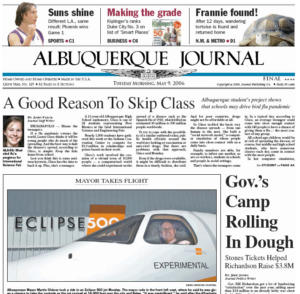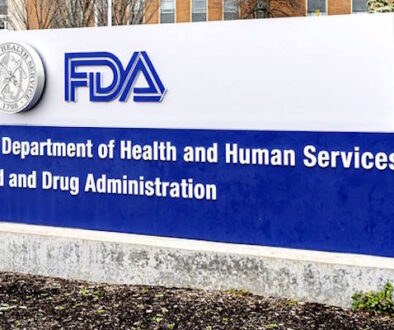Social Distancing Born In Teen’s Science Project
Fourteen years ago this month, during the Intel International Science and Engineering Fair in Indianapolis, Laura Glass, a 15-year-old Albuquerque High sophomore, laid out her plan for slowing the spread of pandemics.
It was very much to the point. Close the schools and keep the kids at home.
“It spreads like crazy once it gets in the teens in the schools,” Glass told Albuquerque Journal science reporter John Fleck, who was covering the event.
Glass was one of 1,500 students, 24 of them from New Mexico, attending the science and engineering fair in May 2006.
Her project, based on computer simulations of human interaction, impressed the judges enough to win her third place in the medicine and health category at the Intel fair that year.
But amazingly, and much more significantly, her work motivated research that resulted in the social distancing and self-isolation policies now being used to curtail the spread of COVID-19.
“The inspiration, the sparks came from my daughter,” said Robert J. Glass, a retired Sandia National Laboratories senior scientist. Glass was among those who built on Laura Glass’s project to develop the vital strategies that are employed today.

‘What about diseases?’
In an exchange of emails with the Journal, Laura Glass, now 29, declined to be interviewed for this article.
Her father, however, spoke to the Journal by phone from northern Idaho, about 30 miles from the Canadian border, where he now spends part of each year.
Robert Glass, 63, retired from Sandia in 2013. But 15 years ago, he was working with the National Infrastructure Simulation and Analysis Center (NISAC) at Sandia.
He said he often worked from home, and Laura would be looking over his shoulder while he was at his computer.
“Her project was a multiyear kind of effort, and it dovetailed with work I was doing – complex systems modeling. You could define a person and put them in a grid, move them around and find who they would come into contact with.
“She said, ‘What about diseases?’ ”
Washington calling
Person-to-person contact is the most common way infectious diseases are spread. Laura, with some guidance from her dad, devised a computer simulation that showed how people – family members, co-workers, students in schools, people in social situations – interact.
What she discovered was that school kids come in contact with about 140 people a day, more than any other group.
Based on that finding, her program showed that in a hypothetical town of 10,000 people, 5,000 would be infected during a pandemic if no measures were taken, but only 500 would be infected if the schools were closed.
Even before that staggering revelation earned Laura Glass third place at the 2006 Intel fair in Indianapolis, it was creating a stir on a much bigger stage.
“On Halloween 2005, NISAC received a call,” Robert Glass said. “Could we prepare a brief for Secretary (Michael) Chertoff of the U.S. Department of Homeland Security?”
Something important
The George W. Bush administration, concerned about bioterrorism in the wake of 9/11 and also worried about the next contagious disease outbreak, was looking for a plan to respond to pandemics. The NISAC brief was needed for a Cabinet-level tabletop exercise at the White House.
The question posed, Robert Glass said, was what could be done to avoid disaster if there was no vaccine and limited antiviral supplies.
“I thought, ‘That’s exactly what Laura is working on,’ ” he said. “Her model was right there on the computer. I realized that was something important. I discussed it with her. She said, ‘Why don’t you close the schools?’ I was taking advice from my (high school) daughter.”
Glass ran Laura’s study through Sandia’s computers and worked the results into reports he sent to Washington.
“It looked like a solution if we could get people to prepare for it,” he said.
Logic and science
The refined research suggested that in the case of more intense infections, closures might have to extend beyond schools to workplaces and social situations.
Concerns about the economic and social upheavals caused by insisting people stay at home led to tough opposition.
But after rigorous review and development by more than one agency, the Centers for Disease Control and Prevention made social distancing – called Non-Pharmaceutical Interventions, or NPIs – official U.S. policy in February 2007.
“I was so happy,” Glass said. “I thought we had done an incredible job. We were trying to avoid policy that was based on who you knew. We wanted a policy that was based on logic and science.”
Now, implemented extensively for the first time, that policy is this country’s main weapon in the battle against the coronavirus scourge.
Very effective
Glass remembers that when discussing science projects with his daughter, he always treated her as if she were a graduate student – even when she was in eighth grade.
“I would ask her questions about data, what you could draw data from, what she would do differently the next time,” he said.
And he recalls that sometimes she was already a step ahead, planning the next stage of her project as soon as she had completed the last, one idea spreading to the next like an epidemic.
Laura did not, however, pursue a career in science after high school. She earned an undergraduate degree in religious studies from a college in the Midwest and a master’s in divinity from a large eastern university.
She is on the staff of an interdenominational Protestant church at a prestigious American university.
But her science studies in high school are paying off now.
“It has been very effective,” Glass said of the approaches inspired by his daughter’s high school science projects. “We would have been in a terrible state if we had not implemented these policies. The death tolls would have been so high. If we had done it sooner, we would have saved more lives.”
A tough road
Glass is well aware that social distancing and self-isolation is tough on people, that it is grinding down people’s spirits as it continues.
“Anything new is difficult,” he said. “You have to train people to do this well, without freaking out and calling each other names. But (coronavirus) is preparing us to deal more effectively with future pandemics.
“And there will be more.”
Archived Source: https://www.abqjournal.com/1450579/social-distancing-born-in-abq-teens-science-project.html




